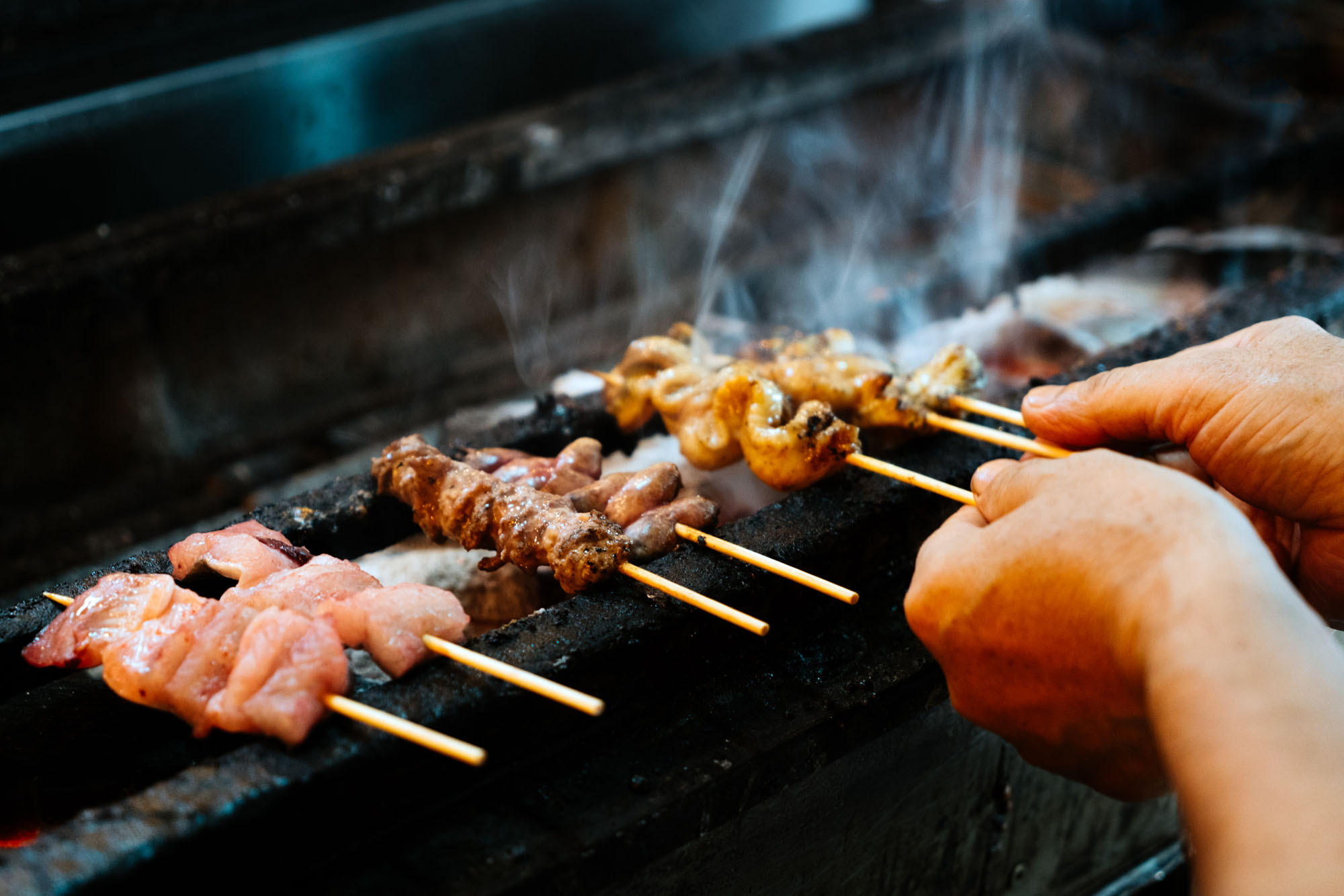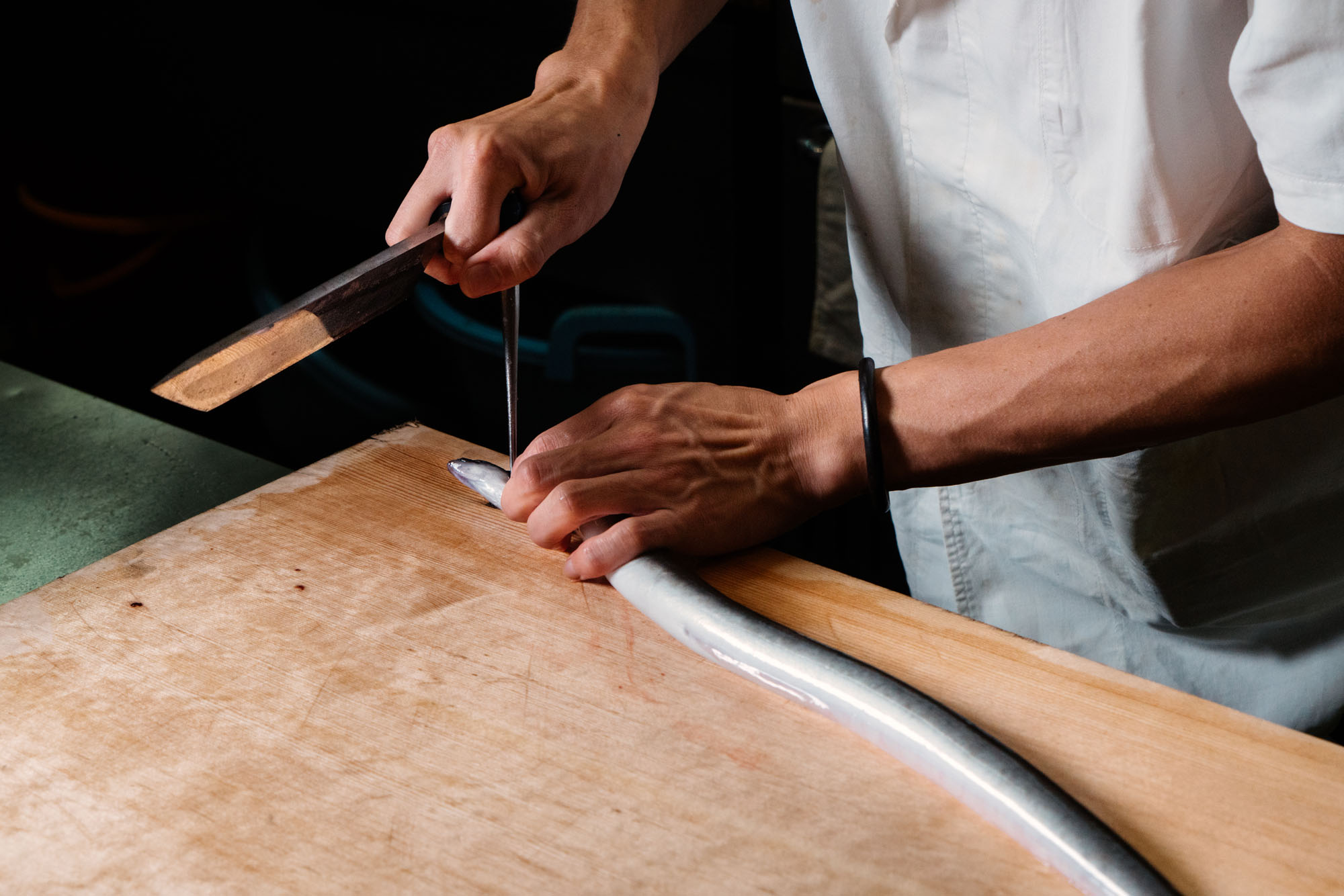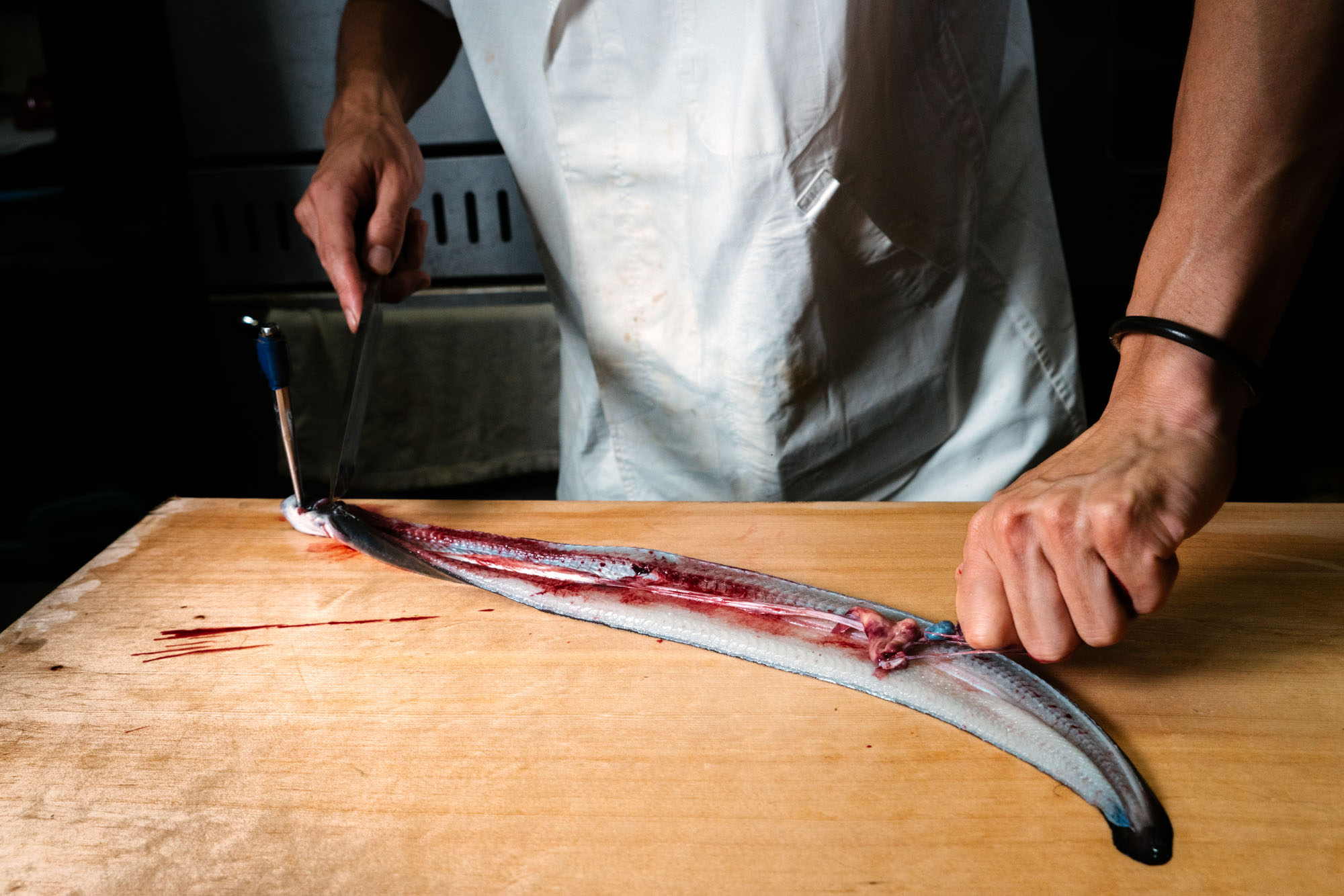FOOD
Is the eel industry on
the slippery slope
to extinction?
Dwindling domestic population threatens a centuries-old tradition
MARK JARNES
Contributing writer
As we approach the end of July, supermarkets nationwide are beginning to stock up on one of the nation’s much-loved summer fish: freshwater eel.
In recent years, however, the cost of eel has risen sharply and consumers are now facing the upcoming Doyo no Ushi no Hi (Day of the Ox, a day dedicated to eel consumption) on July 30 in the knowledge that they’ll be expected to pay through the nose for a slab of the freshwater fish.
Rampant overfishing and the scientific community’s overall lack of knowledge on the biology of eel has left the industry in a crisis. The dwindling domestic eel population has consequently pushed up prices and forced a number of specialist eel restaurants to close. So scarce is the fish in restaurants these days that it’s almost considered to be something of a luxury item.
“I think that the soaring eel prices are truly unfortunate,” says Torami Murakami, chairman of the All Japan Association for Sustainable Eel Aquaculture. “If prices continue to stay at this level, an important part of Japanese food culture will remain out of consumers’ reach.”
Murakami himself enjoys packing away what has become a delicacy, but realizes that increasing prices are making it more difficult for eel to remain on dining tables across the country.
“Eel has been loved in Japan for millennia,” Murakami says. “It’s crucial that we continue this ancient Japanese food culture.”
The eating of freshwater eel — or unagi — is a culinary romance that has lasted more than 5,000 years. Indeed, eel bones have been found in shell mounds dating back to the Jomon Period, which lasted from around 10,000 B.C. to 200 B.C.
Today, eel is typically eaten kabayaki style, in which the fish is split down the belly, gutted and boned, butterflied, cut into fillets, skewered and dipped in a sweetened combination of soy sauce and mirin before being broiled on a grill.
Eel kabayaki is often served on top of a bowl of rice (unadon), while a more extravagant form of this dish (unaju) is placed inside tiered lacquered boxes.
The origins of Doyo no Ushi no Hi extend back as far as the Edo Period, when an eel restaurant owner sought the advice of a prominent inventor called Hiraga Gennai about the prospect of boosting the summer sales of his freshwater fish.
Gennai instructed the restaurant owner to hang a banner in front of his shop that promoted Ushi no Hi and encouraged customers to order dishes that began with the letter “u.” Sales skyrocketed and other eel restaurants soon jumped on the bandwagon, leading to an interest in Doyo no Ushi no Hi that continues today.
Scant optimism: Danzo Yamamoto owns an eel eatery called Ganso Unatetsu in Tokyo’s Shibuya district. Scant optimism: Danzo Yamamoto owns an eel eatery called Ganso Unatetsu in Tokyo’s Shibuya district. | DAN SZPARA
Boom to bust
Although Japan has a long history of eel consumption, fishermen only started grilling the freshwater fish some time during the Kamakura Period (1185-1333). The only seasoning available at the time was salt, miso or vinegar. This primitive form of kabayaki became the basis for what we know and love today.
Eel consumption increased during the “economic miracle” of the decades that followed World War II. Consumers’ enhanced purchasing power, easy-to-eat fillets in modern packaging and aggressive price wars triggered by an increase in imports led to high demand.
As a result of the growing popularity of eel both domestically and abroad, catches have drastically declined in recent years. According to a survey compiled in 2015 by the Ministry of Agriculture, Forestry and Fisheries, the average annual catch of young eel has dropped from more than 200 tons in the mid-1960s to just 20 tons in the 1980s and 1990s. Catches declined further over the 2010s, prompting the International Union for Conservation of Nature to add the freshwater fish to its “red list” of endangered species in June 2014.
Consequently, the majority of eel that makes it onto dining tables nationwide has been imported from China and Taiwan since the 1990s. According to the 2015 fisheries ministry survey, eel imports now account for approximately 60 percent of the domestic eel supply, with a large quantity of the fish being processed into kabayaki in China and shipped to Japan in a ready-to-cook form.
According to another survey released this month by the fisheries ministry, the market price of baby eel — also known as elvers or glass eels — is currently ¥1,820,000 per kilogram. By contrast, the market price of baby eel was ¥160,000 per kilogram In 2003, less than 10 percent of the existing price.
“We want to effectively manage eel resources and continue the country’s culinary heritage,” Murakami says. “We aim to limit the number of glass eels put into lakes in the region to 70 percent in a bid to allow for the perpetual conservation of eel reserves.”
When trying to pinpoint reasons for the declining volume of eel catches, it is important to keep in mind that many aspects relating to an eel’s biology remain unclear. That said, researchers believe that factors such as changes in the ocean environment, habitat degradation and overfishing haven’t helped sustain eel numbers.
Modern-day aquaculture techniques alone aren’t sufficient to restore eel stocks largely because the world’s current knowledge of eels is surprisingly limited — not enough is yet known about the lifestyle of the freshwater fish to breed them in captivity.
As a result, grass eels are caught in the wild and then placed into ponds to be raised for a period lasting between six and 18 months. During this time, eels develop from a miniscule 0.2 of a gram to adults weighing up to 300 grams each. They are then graded into different size categories and transported to processing plants and restaurants for market consumption.
The race to successfully breed eels in farms is an ongoing one, but Murakami and his team at the All Japan Association for Sustainable Eel Aquaculture are hopeful.
“We need to stabilize the breeding process of eels,” he says. “We are getting close to a large-scale implementation of artificial hatching. If we can be successful with that then I believe that eel numbers can return to normal levels.”
We need to stabilize the breeding process of eels. We are getting close to a large-scale implementation of artificial hatching. If we can be successful with that then I believe that eel numbers can return to normal levels.”
Like father, like son: Shohei Hashimoto stands with his father in the kitchen of Unagi Hashimoto in Tokyo. | DAN SZPARA
A family business
Amid this glimmer of hope, one wonders how the steady decline in eel resources has affected restaurateurs and their customers.
Shohei Hashimoto of Unagi Hashimoto speaks frankly about the financial pressure he has faced in recent times. “Prices have gone up, especially over the past four or five years.” he says. “Accordingly, the number of customers has dropped.”
This year, Hashimoto became the fourth in a line of Hashimotos to take the reins of the family business after serving for over a decade of training under his father’s wing. The two-story restaurant in Tokyo’s Nihonbashi district has been in business since 1947 and, as with previous generations, the restaurant will slowly undergo changes under new management — Hashimoto believes the eel industry is in need of an image change.
“I’m 37, and the person who runs the organic eel farm that we buy our produce from is around the same age as me, so we have similar views toward farming and distribution,” Hashimoto says. “He was the first farmer that has reached out to restaurants as a brand. If you go to supermarkets and eateries, you’ll see the name of the farmers on the packages, but the eel business is still old-fashioned, so consumers don’t really have an idea of where the eels come from and who farms them. I think this needs to change.”
True to his word, the newly updated Unagi Hashimoto website describes in detail where the restaurant sources its eels. The website also boasts of a “modern classic” approach to unagi culture.
“Since I am the fourth in a line of Hashimotos, there is a lot to take on and pass on,” he says. “However, the world is moving forward at an incredible pace and I think that we need to expand our focus as a restaurant. Eels are a freshwater fish, so I think that there is a lot of potential in also trying to serve other such fish at a high level of quality in order to emphasize the taste of eel.”
Hashimoto’s menu reflects this ethos. There is toriju (grilled chicken on rice) and a course dinner at Unagi Hashimoto, which will cost between ¥8,500 and ¥11,000, includes sashimi and a freshwater-fish bowl.
However, Hashimoto is not abandoning all outmoded cooking methods. He plans to bring back charcoal to his grills, instead of the electric ones that his restaurant now uses.
“It’s not a big difference, but the difference is clear,” he says, smiling.
Considering the excellent quality of their dishes, lunches are more reasonable at Unagi Hashimoto, with their eel-only menu totaling ¥1,620.
“We want to target businessmen and women during their lunch hours, so we have decided to serve a half-cut of kabayaki to make it more affordable for them to come in without burning a hole in their pockets,” Hashimoto says. “We used to have more options for lunch. But with eel stocks decreasing, prices increasing and the number of eel chefs declining, we decided to keep only what we thought were the best options.”
When asked if he is hopeful of an increase in catches and a consequent decrease in costs that should lead to more customers coming in through his doors, Hashimoto responds cautiously.
“2015 may see a slight increase in eels catches,” he says, “but no one knows what will happen in years to come.”
Danzo Yamamoto, owner of an eel kushiyaki (grilled skewered food) restaurant called Ganso Unatetsu in Tokyo’s Shibuya district, is not optimistic of what the future holds for his family-run establishment.
“We had to raise our prices four years ago, when the catch was low, and this year is looking to be almost as bad,” he says. “It’s already summer, so I’m not sure that we can raise the prices at this point in the year.”
Unlike Unagi Hashimoto, Ganso Unatetsu offers an all-eel menu, a tradition that has been passed down to Yamamoto since his grandfather started the restaurant in 1957.
The right end of the stick: A man grills skewers of eel at Ganso Unatetsu in Tokyo’s Shibuya district. | DAN SZPARA
In contrast with other kushiyaki restaurants, which also serve yakitori chicken skewers, Ganso Unatetsu only serves eel, with individual skewers ranging in price from ¥130 to ¥260. However, Yamamoto realizes that, at least in terms of revenue, this generation-crossing tradition is not enough to keep the shutters from closing.
“Compared to many other places (nationwide) that serve eel as unaju, our main revenue comes from grilled skewers,” he says, explaining how he has managed to stay afloat so far. “We also use the entire eel, from the head to the innards to the fins and tail. That’s something that my grandfather came up with when the restaurant was established.”
As innards and fins are cheaper than the softer and fluffier kabayaki, this is a clever — and delicious — attempt at branding and cost-cutting. But Yamamoto says that offering an eel all-star menu simply isn’t quite enough to cut it these days.
“A lot of our sales also comes from serving alcohol, especially beer,” he says. “Since we are a kushiyaki restaurant, we decided to go with an izakaya(Japanese pub) atmosphere.”
Located in close proximity to Shibuya Station and surrounded by izakaya, it appears that this was a wise business maneuver. When this interview came to a close at 6:30 p.m., a few salarymen had already formed a line outside of the packed restaurant. Still, Yamamoto remains skeptical.
“To be honest, in my next life I don’t think I’d choose to be in the eel business,” he says. “And unless we can see an increase in production and a decrease in costs, I wouldn’t really want my son to go into it either. I’d worry too much.”
Unagi: Culinary concepts
Consumption history
The consumption of freshwater eel in Japan dates back to the Jomon Period (10,000 B.C.-200 B.C.). In modern times, eel is typically eaten kabayaki style, in which the fish is split down the back (or belly), gutted and boned, butterflied, cut into fillets, skewered and dipped in a sweetened combination of soy sauce and mirin before being broiled on a grill. However, it was traditionally marinated with salt, vinegar, and either miso or red peppers before being boiled.
Filleting styles
In the Kanto region, eels are sliced open down the back of the animal and grilled unglazed. In the Kansai region, however, eels are split down the belly. The warrior class in Kanto considered gutting an eel via the belly to be bad luck, as it was associated with seppuku (ritual suicide by disembowelment).
Pepper pairing
Japanese peppers (sansho) are believed to be effective in regulating the temperature of our internal organs, which aids digestion. The peppers are also believed to help digest the fatty parts of an eel’s body.
Freshwater vs. saltwater
Unagi is a freshwater eel, whereas anago (conger) is a saltwater variety. Anago is sometimes consumed as a cheaper alternative to unagi. Unagi and anago have a similar taste, but the freshwater fish has higher fat content compared to its saltwater cousin.
Nutritious value
Eels contain multiple vitamins — vitamin A, B1, B2, D and E — as well as DHA and EPA (deficiencies that correlate with learning and memory deficits) and minerals such as iron, calcium and zinc. Eel consumption is believed to help prevent high blood pressure, strokes and even the loss of vision. (Chinatsu Yajima)
Unagi: Enigmatic creatures
Male majority
The sex ratio for freshwater eels caught in the wild is nearly equal. However, eels that are raised in farms for consumption are predominantly males. Genetically, some varieties of fish change sex as a result of environmental factors. For instance, researchers have shown that female fish artificially reared in waters that are kept at a high temperature during the larval stage can become male. More research is needed on the higher incidence of farmed male eels, but there seems to be a correlation between high-density breeding and male bias.
Long life span
The oldest freshwater eel ever recorded in an aquarium lived to be 80 years years. As eels typically die after spawning, reproductive suppression could help to extend an animal’s life span. Also, an eel in an aquarium reportedly survived without eating food for 22 months.
Poisonous blood
Eels are not typically served as sashimi because their blood contains ichthyotoxin, which causes symptoms such as respiratory distress and nausea. Since the poison is proteinaceous, cooking eel meat destroys the toxin. This isn’t to say, however, that eel sashimi is never consumed in Japan. Some specialist chefs are able to drain the blood perfectly and marinate the meat with vinegar.
Slippery slime
The slime on eels’ bodies helps preserve the animal’s moisture as well as cutaneous respiration. The slime is produced by the secretion of glycosylated proteins such as mucin and mucoprotein. It also serves to control the osmotic pressure between the external environment and inside their bodies.
Softer side
Eels are soft when consumed after being heated. When eaten raw, eels can be as hard as rubber. Eel meat contains collagen and heat helps to liquefy it to gelatin. (Chinatsu Yajima)
Published July 23, 2016




